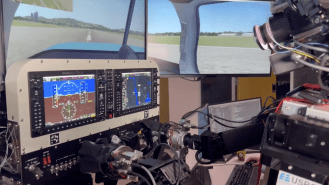A humanoid robot pilot designed to fly a variety of airplanes is ready to leave the flight simulator behind and get into the cockpit of a real plane, according to its South Korean creators.
The challenge: Being an airplane pilot is a physically, mentally, and psychologically demanding job, and unfortunately, those conditions can sometimes lead to mistakes — while air travel is incredibly safe, pilot error remains a leading cause of the accidents that do occur.
The same way that autonomous cars are expected to make our roads safer, replacing pilots with autonomous systems could potentially reduce the number of accidents in our skies. Including private aircraft, there are hundreds of thousands of planes in the world, though, and custom modifying a large percentage of them to be autonomous would be a huge, expensive undertaking.
“PIBOT is a humanoid robot that can fly an aeroplane just like a human pilot by manipulating all the single controls in the cockpit.”
David Shim
Robot pilot: Instead of trying to make planes autonomous, researchers at the Korea Advanced Institute of Science are Technology (KAIST) are developing PIBOT, an AI-powered humanoid robot pilot designed to fit in the cockpit and fly unmodified airplanes.
“PIBOT is a humanoid robot that can fly an aeroplane just like a human pilot by manipulating all the single controls in the cockpit, which is designed for humans,” lead developer David Shim told Euronews Next.
How it works: The KAIST team demonstrated the first version of PIBOT in 2014, but that model was small and could only control a scaled-down simulation of an airplane’s control panel. The new PIBOT is 5’3” and 143 pounds, allowing it to train on full-sized flight simulators.
Today’s PIBOT is also a better communicator than its predecessors.
Thanks to recent advances in large language models (AIs that can understand and respond to prompts in natural language, like ChatGPT) and voice synthesis tech (the kind that lets AI assistants like Siri speak to you), it can not only fly the plane but also talk to air traffic controllers and other pilots, ensuring everyone is on the same page during a flight.
This ability to understand natural language also means the humanoid robot pilot can be easily trained to fly a variety of planes, according to the researchers — all they have to do is feed its AI the correct flight manuals — and memorize navigation charts from across the globe.
“[PIBOT has] emergency response times quicker than human pilots.”
KAIST
PIBOT has proven capable of handling all aspects of flight in simulations, including taxiing, takeoff, and landing, accurately operating controls even during harsh turbulence. It’s also already demonstrated some advantages over human pilots.
“[PIBOT can] respond immediately to various situations, as well as calculate safe routes in real time based on the flight status of the aircraft, with emergency response times quicker than human pilots,” according to the KAIST team.
“We expect [PIBOTs] to be applied into various other vehicles, like cars.”
David Shim
Looking ahead: Whether PIBOT is as reliable as a human pilot will need to be determined by a lot of hours in the sky, and the KAIST team is now gearing up to give the bot control over a light aircraft, with the expectation of wrapping up development in 2026.
The group has received funding from South Korea’s Ministry of National Defense and is currently considering both military and civilian uses for its humanoid robot pilot. They aren’t limiting themselves to aircraft, either.
“Humanoid pilot robots do not require the modification of existing aircrafts and can be applied immediately to automated flights,” said Shim. “They are therefore highly applicable and practical. We expect them to be applied into various other vehicles, like cars and military trucks, since they can control a wide range of equipment.”
We’d love to hear from you! If you have a comment about this article or if you have a tip for a future Freethink story, please email us at tips@freethink.com.
